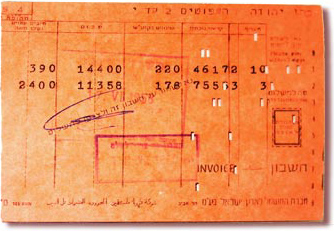
|

|
This is an old cardboard utility bill, showing quite a few languages -- Hebrew, Arabic, English,
some barely legible rubber stamps and an illegible scrawled signature. But the most interesting one,
technologically, is the language that only a computer could read -- the punched holes.
Punched cards were used extensively by programmers to program mainframe computers (the only kind that existed
at the time), but here we see how they were also shared with ordinary mortals, in what for most citizens in the
fifties was as close as they ever got to a computer.
|

Click photo to enlarge
|

|

|
This is a monthly bill of the Israel Electric Company, dating back to 1958 (or is it '53? The
date is too faded to tell for sure). For about 2 decades, until optical-reader fonts were introduced on bills,
this technology was ubiquitous and familiar to all. It appears that another section of the card had been torn off
and kept as a receipt; the part shown here was sent to the company upon payment. The punched holes were used to
allow a computer to credit the account, and possibly to sort the cards for archiving. As a matter of fact, this
application predates the electronic computer -- Herman Hollerith introduced punched cards for tabulation of the
1890 US Census, where they were sorted automatically according to the hole patterns. He then went on to found
the Tabulating Machine Company, which later became IBM...
Exhibit provenance:
This is a gift from my friend Eli, who donated it to my collection.
|





